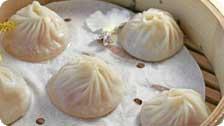by Jill Richardson, Granola Diva
Ordering Chinese food in China is a job best done by experts. One of my Chinese friends tells me she thinks the oldest person at the table orders for everyone because it requires age and experience to acquire the necessary skill. Never was this more apparent than during my first meal in China.
A few hours after my plane touched down in Beijing, I joined my friends at a restaurant on the west side of the city. Armed with one year of beginner’s Chinese classes and a few phrasebooks, we sat down to give it our best.
“Jiaozi.” The first person ordered dumplings, one of the approximately five Chinese dishes I knew how to say in Mandarin.
“Duoshao? Yi jin?” The waitress asked how many dumplings he wanted. One jin (approximately one pound)? My friend agreed.
We went around the table ordering. Three others ordered one jin of jiaozi and our resident vegetarians ordered a dish or two for themselves. It was only when our food arrived that we realized our mistake.
The Chinese dine family style. You should always order several dishes to share with your entire table. The waitress did not suggest that one person should eat one jin of jiaozi; she suggested the amount (approximately 30 dumplings) for our entire table of seven people! The seven of us sat there for over an hour in front of a mountain of dumplings, barely able to consume one-fourth of it.
Once I adjusted to dining Chinese style, each meal was better than the last. In the United States, I do not even like Chinese food; in China, I love it. Authentic Chinese cooking uses big, fresh vegetables and tender chunks of meat. Different regions boast their own unique cuisines (such as the spicy Sichuan style of cooking), and a big city like Beijing has restaurants devoted to each of the various styles. All summer long, I ate and ate and ate (and I lost weight!).
If you are traveling to the Far East, here are tips I collected for successful dining as a Westerner in China:
Jill’s Ten Tips for Ordering Food in China:
1. Bring along a bilingual Chinese take-out menu from the U.S. Using your menu, you can point to mapo tofu or beef and broccoli, even if your waiter speaks no English and you speak no Chinese.
2. Find a few favorite dishes that you can depend on as staples. Mine were yaoguo jiding (cashew chicken), liangban huanggua (cold dressed cucumber), and jiachang doufu (home style tofu), to name a few. I like exploring and trying new things, but sometimes I just couldn’t read the scribbly handwritten characters on the menu and I was too hungry to try.
3. If you are dining with Chinese friends, especially in a formal situation, as a rule of thumb, do not ask about a food unless you plan on eating it no matter what the answer may be. Too many times, I held a piece of food in my chopsticks only to find out that it was duck’s stomach, sea cucumber, jellyfish, or some other delicacy. At that point, I had to eat it anyway to avoid offending my host.
4. The Chinese still cook with MSG. You can tell them “bie fang weijing” (“do not use MSG”), but they often add MSG anyway. My Chinese friends tell me those serious about eating MSG-free Chinese food should explain to the waiter that they have deadly MSG allergies. For extra emphasis, add that you will die at the table and the waiter will be responsible for disposing of your body.
5. It is relatively easy to be a vegetarian in China. There is no shortage of fresh vegetable and tofu dishes. Be sure to tell your server “Wo chi su” (“I am vegetarian”).
6. In Chinese, the generic term for meat (rou) refers to pork. Other types of meat are referred to specifically as chicken meat (jirou) or cow meat (niurou), etc.
7. There is great food to be had from roadside stands. My favorites included fruits such as bananas, lychee, watermelons and peaches, and breakfast items like youtiao and doujiang (fried dough and soy milk).
8. Practice using chopsticks before you leave for your trip. In many parts of China, western silverware is rare. Even in the event that a restaurant offers you a fork, it’s nice to be able to turn it down and then show off your chopstick skills. Also, do not stick your chopsticks vertically into your food. This is rude because it resembles incense, which is burned for the dead.
9. The Chinese do not “go dutch.” It’s customary to take turns paying for the entire meal. Dining is so inexpensive that it feels great to treat your entire party to dinner and drinks—for a total of $10! (And remember, the Chinese do not tip.)
10. On a related note, the Chinese like to bicker over who has the honor of paying for meals. If your host offers to pay, you should object a few times and tell them you wish to pay. Ultimately, after refusing a few times, let your host pay for the meal.







